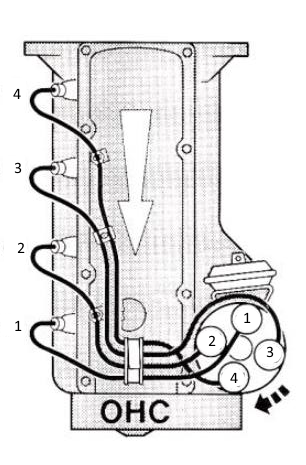The Ford Pinto, introduced in the 1970s, is a compact car that became an iconic part of Ford’s lineup during its time. Its simplicity and reliability are hallmarks of its design, and at the heart of its operation is its four-cylinder engine. Understanding this engine’s firing order is critical to maintaining its smooth and efficient performance.
In this article, we’ll explain the firing order of the Ford Pinto engine, provide tips for troubleshooting and maintenance, and discuss its importance.
This guide will give you the essential knowledge, whether you’re restoring a Pinto, tuning its engine, or simply interested in classic automotive mechanics.

Quick Navigation
The Ford Pinto Firing Order
The firing order for the Ford Pinto’s inline-four engine is: 1-3-4-2

How the Firing Order Works
- Cylinder 1 Fires First: The frontmost cylinder initiates the combustion process.
- Cylinder 3 Fires Second: Ignition moves to the third cylinder, skipping the second.
- Cylinder 4 Fires Third: The rearmost cylinder ignites next.
- Cylinder 2 Fires Last: Combustion ends with the second cylinder, completing the sequence before restarting with Cylinder 1.
This alternating pattern ensures balanced power delivery and smooth operation.
Why Ford Uses the 1-3-4-2 Firing Order
The 1-3-4-2 firing order is specifically chosen to optimize the Pinto engine’s performance and longevity. Here’s why it works:
- Balance: Alternating combustion events prevent excessive vibrations and stabilize the engine.
- Efficiency: Proper timing allows the air-fuel mixture to burn completely, maximizing power and minimizing waste.
- Simplicity: The inline-four layout naturally complements this firing order for reliable operation.
- Durability: Evenly distributes forces across the crankshaft, reducing wear and tear.
What Is a Firing Order?
The firing order refers to the sequence in which an engine’s spark plugs ignite the air-fuel mixture in each cylinder. This combustion sequence drives the pistons, rotates the crankshaft, and powers the vehicle.
In a four-cylinder engine like the Pinto’s, the firing order is specifically designed to balance performance, minimize vibrations, and optimize efficiency.
Why the Firing Order Matters
- Smooth Operation: Ensures even combustion and reduces vibrations.
- Performance: Maintains consistent power delivery and steady operation.
- Efficiency: Promotes complete combustion, improving fuel economy and reducing emissions.
- Durability: Distributes mechanical stress evenly, prolonging the engine’s lifespan.
Overview of the Ford Pinto Engine
The Ford Pinto’s most common engine is the 2.3-liter inline-four, although other configurations, such as the 1.6L and 2.0L, were also offered. These engines are known for their straightforward design, which makes them easy to work on and reliable over time.
Key Features of the Ford Pinto Engine
- Inline-Four Layout: Four cylinders arranged in a straight line.
- Overhead Camshaft (OHC): Operates the intake and exhaust valves.
- Carbureted Induction: Delivers the air-fuel mixture through a carburetor.
- Cylinder Numbering:
- Cylinders are numbered sequentially from front to rear:
- Cylinder 1 is closest to the radiator.
- Cylinder 4 is closest to the firewall.
- Cylinders are numbered sequentially from front to rear:
Identifying the Firing Order
To correctly apply the firing order, it’s important to understand the cylinder layout and ignition system.
Cylinder Numbering
- Front to Rear: Cylinders are numbered 1 through 4, with Cylinder 1 at the front (near the radiator) and Cylinder 4 at the rear (near the firewall).
Distributor Orientation
The distributor controls the timing and sequence of the spark. Ensure the spark plug wires are routed correctly from the distributor cap to the corresponding cylinders based on the firing order.
Symptoms of an Incorrect Firing Order
An incorrect firing order can disrupt the engine’s performance and lead to noticeable problems. Recognizing these symptoms can help you diagnose and fix issues quickly.
Common Symptoms
- Engine Misfires: Cylinders fire out of sequence, leading to uneven power delivery.
- Rough Idling: The engine vibrates excessively or feels unstable when idling.
- Power Loss: The car struggles to accelerate or maintain speed due to inconsistent combustion.
- Backfiring: Ignition timing errors may cause explosions in the intake or exhaust manifold.
- Increased Fuel Consumption: Inefficient combustion results in higher fuel usage and emissions.
Diagnosing and Fixing Firing Order Problems
If you suspect issues with the firing order in your Ford Pinto engine, follow these steps to diagnose and resolve them:
Diagnostic Steps
- Inspect Spark Plug Wires: Verify that each wire is connected to the correct cylinder according to the 1-3-4-2 firing order.
- Check the Distributor: Ensure the distributor rotor aligns with the correct spark plug wire during ignition.
- Use a Timing Light: Confirm that ignition timing matches the manufacturer’s specifications.
- Perform a Compression Test: Check for adequate compression in all cylinders to ensure proper firing.
Fixing Common Issues
- Reconnect Spark Plug Wires: Route wires correctly to their respective cylinders.
- Adjust Timing: Use a timing light to align the distributor rotor with the firing order.
- Replace Faulty Components: Install new spark plugs, ignition wires, or distributor caps if they are worn or damaged.
Preventative Maintenance for Firing Order Reliability
Maintaining the correct firing order is essential for the Ford Pinto engine’s performance and longevity. Follow these preventative tips to avoid issues:
Regular Inspections
- Check the condition of spark plugs, ignition wires, and distributor components during routine maintenance.
- Look for signs of corrosion, wear, or loose connections.
Replace Components as Needed
- Replace spark plugs and ignition wires according to the recommended maintenance schedule.
- Use high-quality OEM parts to ensure reliability and compatibility.
Verify Timing
- Periodically inspect ignition timing and adjust it using a timing light if necessary.
- Reconfirm the firing order whenever replacing ignition components or performing major engine repairs.
FAQs About the Ford Pinto Firing Order
Can I Change the Firing Order?
No, the firing order is fixed by the engine’s design and crankshaft configuration. Altering it would require extensive mechanical modifications.
What Happens If the Firing Order Is Incorrect?
An incorrect firing order can cause misfires, rough operation, power loss, backfiring, and potential damage to internal components.
How Can I Verify the Firing Order?
Refer to the service manual, inspect spark plug wiring, and use timing tools to confirm the ignition sequence.
Is the Firing Order the Same for All Inline-Four Engines?
While many inline-four engines use the 1-3-4-2 firing order, variations can exist depending on the manufacturer and engine design.
Engines with Similar Firing Orders
- 429 Ford Firing Order
- Ford 239 Y Block Firing Order
- Ford V10 Firing Order With
- Ford 460 Firing Order With
- Ford 272 Y Block Firing Order
Conclusion
The 1-3-4-2 firing order is a critical component of the Ford Pinto’s inline-four engine, ensuring smooth operation, balanced power delivery, and efficient combustion. Understanding and maintaining this firing order is essential for keeping your Pinto running reliably, whether you’re restoring a vintage model or performing routine maintenance.
By following proper maintenance practices, verifying ignition timing, and addressing issues promptly, you can maximize the performance and longevity of your Pinto’s engine. Whether you’re a seasoned mechanic or a classic car enthusiast, mastering the firing order is a key step in caring for this iconic compact car.

